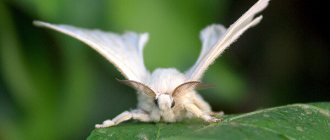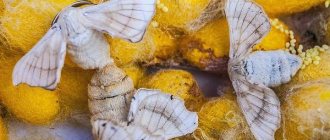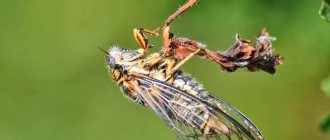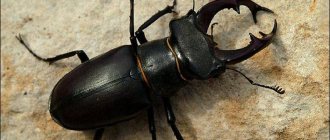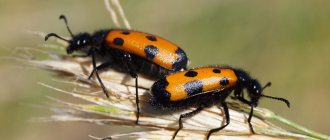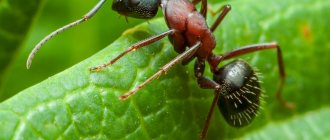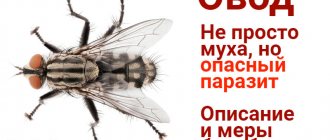When hearing the word “grasshopper,” many people remember a simple children’s song and imagine a green, harmless creature that “doesn’t even touch a booger.” Alas, the grasshopper is a predator. And not only boogers, but also flies, ticks, butterflies - their favorite delicacy.
The grasshopper is an arthropod insect belonging to the order Orthoptera. There are about seven thousand species of them on the globe.
Habitats
The grasshopper can be found in every corner of the earth except Antarctica. He prefers green edges, valleys, gorges in which lush grass grows. In Central Asia, it lives high in the mountains, trying to hide among plants from the scorching sun.
In the Alps, the grasshopper chooses high-mountain meadows, loves open spaces, and avoids forests. You can meet a grasshopper in the Far East and Africa, in Denmark and Finland, in England and in the sultry jungle.
Larva
Grasshoppers are insects with incomplete metamorphosis, that is, their larva resembles a smaller copy of the adult, only without wings. The ancient genus of Orthoptera has reached our days from distant times, when the coal seams were formed, and has not changed at all since then.
Grasshopper larva
The life of a green grasshopper does not begin in a meadow, but in the soil, at a depth of about 5-7 centimeters. There the insect emerges from the egg and begins the difficult journey towards the sun. The first instar larva (that is, before the first molt) is half a centimeter in size and is dressed in a whitish case that fits tightly, with a bubble in the back of the head. Moving like a worm, it moves upward, and the bubble, swelling and falling, serves to push apart the soil particles. Having encountered a stone on the way, the larva is doomed, because it can only move in a straight line. There are about 60 eggs in the clutch, but only the strongest and luckiest, about 10%, come to the top.
At the top, the insect takes off its temporary “space suit.” After waiting a little for the chitinous covers to harden under the sun, the larva begins to feed. She prefers the most tender parts of the leaves. During the season, the insect molts several times, increasing in size until it reaches the adult stage. As the larva grows, its menu also undergoes changes.
In middle age, the basis of the diet consists of grass seeds in the stage of milky ripeness, but the young grasshopper already shows predatory tendencies, destroying clumsy aphids and clutches of other insects encountered along the way. Hairless caterpillars are readily eaten. Gradually, the jaws become stronger, and older larvae easily cope with small locusts.
Color palette
The color of a grasshopper depends on its habitat and species. The grasshopper living in Russian meadows and clearings or in the tropical zone has a camouflage green color. A desert grasshopper or one that has chosen a marshy area is spotted and brown.
South African grasshoppers camouflage themselves with the color of rocks to escape predators. Striped and peacock colors are also found. But orange and red grasshoppers came to Russia from China, and you can only admire them in greenhouses.
Phylogeny, species
They belong to the suborder Caelifera. It includes about 2,400 genera and 11,000 known species. There are probably many undescribed species, especially in tropical rainforests. They have a predominantly tropical distribution. Found all over the world. They are almost exclusively herbivores.
The most diverse superfamily is Acridoidea, with about 8,000 species. The two main ones are Acrididae (grasshoppers and locusts) with a worldwide distribution, Romaleidae (lubber grasshoppers), found mainly in the New World.
Ommexechidae, Tristiridae - South Americans, Lentulidae, Lithidiidae, Pamphagidae - African. Paulinids are nocturnal and can swim or walk on the surface of the water.
Lentulides are wingless. Pneumorids are native to Africa, especially the southern part, and are distinguished by a swollen abdomen in males.
Features of reproduction
Males attract females with loud singing. After mating, the female eats the spermatophore, which consists of seminal fluid and a sticky substance. The seminal fluid enters the female's oviduct. Eggs are laid within two to three hours. Their number can reach up to 1000.
Eggs are laid in shallow holes, on grass stems or under the bark of trees and remain there throughout the fall and winter. The larvae hatch in the spring. They molt several times and, bypassing the pupal stage, immediately turn into a grasshopper.
Some species of female insects do without males and lay unfertilized eggs, from which only female grasshoppers grow.
Secrets of the one sitting in the grass
Externally, grasshoppers are very similar to locusts. Main differences: locust whiskers are short, females do not have an ovipositor. Grasshoppers do not form a herd form; they bring more benefit to agriculture than harm.
The most typical representative of this genus for our latitudes is the green grasshopper (Locusta viridissima L.). The spectacular large insect lives where there is high grass. The protective coloring makes it invisible - when the grasshopper does not move or sing, it is not easy to notice. Along the sides of the insect’s body there is a lighter stripe, similar to a grass stem, which camouflages it even better. The female differs from the male in its larger size and the presence of a saber-shaped ovipositor.
Female green grasshopper
The grasshopper is secretive and timid. Disturbed, it either falls into the thick grass or jumps, opens large transparent wings in the jump and flies away from its pursuer. It is quite difficult to observe grasshoppers in nature, so much of their life remains “behind the scenes” for people, including their feeding habits. Meanwhile, this creature can transform in an amazing way: from a vegetarian it turns into an agile predator, capable of catching a victim twice its size.
Favorite food
A grasshopper will gladly swallow a caterpillar, a butterfly, small insects, larvae, and even representatives of its own species that turn out to be weaker than it. But he does not disdain plant foods, namely: grass, stems, flowers, cereals and the like.
Oddly enough, grasshoppers even bite people (though not to get enough) who threaten them. The bite of a grasshopper is painful, because the insect has strong, powerful jaws.
Blood circulation and breathing
Grasshoppers have an open circulatory system. Their body cavities are filled with hemolymph. The heart-shaped structure of the upper abdominal cavity pumps fluid to the head, where it flows through tissues and organs back into the abdominal cavity.
It moves nutrients throughout the body and removes metabolic waste. Other functions of hemolymph include wound healing, heat exchange, and providing hydrostatic pressure. The circulatory system does not participate in gas exchange.
Breathing is performed using tracheas, air-filled tubes that open onto the surface of the chest and abdomen through spiracles.
Large insects require active body ventilation. Use the abdominal muscles to expand and contract the body, pumping air through the system.
Loud-voiced singer
The grasshopper chirps on a cool day or in the evening, and occasionally at night. This happens thanks to its elytra, which act as a kind of musical instrument.
As a result of vibration, a sound appears that intensifies when the insect's wings rise. Each type of grasshopper has its own melody.
It is called the music of nature. During the mating season, males make a peculiar crackling sound, which females cannot do.
Sensing danger, the grasshopper immediately falls silent. This is how he escapes from his enemies. To hear a clear-voiced singer, you should not talk loudly or make sharp sounds. Listen to the silence and you will hear the trill of a grasshopper.
Captivity
In a number of Asian countries, the grasshopper is considered a popular pet, along with the cricket. Pleasant sounds are produced by males of the species Tettigonia cantans (singing grasshopper) and some others. Chinese breeders have even developed several breeds that sing differently than their wild ancestors. The price of a particularly “euphonious” grasshopper reaches $20.
Middle zone grasshoppers can also be kept at home. Their food is lettuce leaves, unripe ears of wild cereals, berries, pieces of apples, pears and other fruits. Beetles, small locusts and other living creatures will be eaten at night, but if the grasshoppers are hungry, the hunt will take place at any time of the day. When the time comes for females to lay eggs, it is better to lay them one at a time, otherwise the struggle for territory will lead to fights and cannibalism. And the males will live peacefully with each other and chirp until the fall.
Pest or helper?
A grasshopper can bring both harm and benefit to people. For example, it destroys buds, flowers and leaves of vineyards, tobacco plants, citrus fruits, and tea.
Summer residents also do not want to see grasshoppers on their plots, since its larvae are terribly voracious, and during molting they feed on young shoots.
However, grasshoppers can also be useful. They perfectly fight the Colorado potato beetle, which often attacks potatoes, eat harmful larvae that mutilate tree bark, and exterminate insects that eat plants.
Nutrition
Among the small insects that inhabit the Earth, there are also cruel predators. Grasshoppers are one of them. These are natural, skilled hunters. They try to grab their prey with lightning speed, using their forelimbs. They feed on larvae as well as small insects, eating small locusts, mites and aphids.
Grasshoppers also eat beetles, butterflies, and caterpillars. In cases of shortage of other types of food, especially if they find themselves captive in a confined space, they are capable of attacking their own relatives in a wave.
Flowery grasshopper eating leaves
And sensing luck, the stronger will feast on the weaker with appetite, without hesitating at all. To get their required dose of nutrients, salts and protein, these insects are able to consume carrion and feces.
Grasshoppers can be attracted to plant leaves from plant food, but only on young shoots. There are species for which this type of nutrition is the main and even the only one.
However, in this case, the insatiability of grasshoppers sometimes harms cultivated and forest plants. But by eating harmful insects, in particular the Colorado potato beetle, which destroys potato plantings in huge quantities, grasshoppers turn out to be very useful.
If you fight, then how?
Plants should be located away from grasshopper egg laying sites. If the green warbler nevertheless settles on the site, pesticides, means for killing beetles, and various kinds of bait with poison are used.
But there are also mechanical methods of protection: digging up the soil in the fall, and loosening the rows more often in the summer.
Today, there are already biologically pure biological products that help fight insects. They are absolutely harmless to humans and animals.
Let's not forget about the birds, for whom the grasshopper is a real delicacy. If the area has been chosen by titmice, then the jumping singers will not stay there for long.
Sense organs
They have an extensive set of external sense organs. On the sides of the head are a pair of large compound eyes that give a wide field of vision. Determine movement, shape, color, distance.
There are three simple eyes on the forehead that indicate the intensity of light, a pair of antennae containing olfactory and sensory receptors, and mouth parts containing taste buds. On the front of the abdomen there are a pair of drum organs for receiving sound.
There are many fine hairs (setae) covering the entire body that act as mechanoreceptors (touch and wind sensors). They are most dense on the whiskers, palps (part of the mouth), and at the tip of the abdomen.
They have special receptors (bell-shaped sensilla) built into the cuticle of the legs that sense pressure and distortion.
They have internal “chordotonal” sensory organs specifically designed to detect position and movement around the joints of the exoskeleton. Receptors transmit information to the central nervous system through sensory neurons.
Watch the video of a grasshopper chirping
Photos of grasshoppers
Locust invasion
Has a swarming phase in the family Acrididae. The formation of a swarm is a response to numbers. Increased tactile stimulation of the hind legs causes an increase in serotonin levels. This causes the grasshopper to change color, feed more, and reproduce faster.
The transformation of a single individual into a swarming one is caused by several contacts per minute over a short period of time.
After this transformation, under suitable conditions, dense nomadic bands of flightless nymphs known as "funnels" form. They secrete pheromones that attract insects to each other.
With several generations per year, locust populations can develop from local groups into huge swarms of flying insects known as plagues.
Devours all vegetation it encounters. The largest recorded locust swarm was formed by the now extinct Rocky Mountain locust in 1875.
It was 2900 km long and 180 km wide. Quantity – 3.5 trillion. Adult desert locusts eat about 2 grams of plant material each day. Billions of insects are very destructive, destroying all plant foliage, stems, flowers, fruits, seeds, bark.
Literature
- Mikrula. Photos of a grasshopper.
- Biology. 7th grade. V. M. Konstantinov, V. G. Babenko, V. S. Kuchmenko, Ventana-Graf, 2009.
- Biology. Animals. 7th grade. V.V. Latyushin, V.A. Shapkin, -M., Bustard, 2009.
- B. M. Mamaev, School atlas - identification of insects., M., Education, 1985.
- School handbook. Biology. Yu. A. Belousov, Yaroslavl, 1998.
- A textbook on biology for applicants to universities. A. V. Ganzhina, Minsk, Higher School, 1978.
- V. P. Gerasimov., Invertebrate animals, studying them at school., Education, 1978.
- P. Marikovsky “To the young entomologist.” M.: Children's literature, 1978. - pp. 50-51.
Adults
By July, the larva molts for the last time, becoming a full-fledged winged insect. On hot days, they tend to be motionless, with their forelimbs extended. This is similar to the pose of their close relative, the praying mantis. Like it, the grasshopper has grasping tentacles on the inside of its legs, but they are smaller. If a hunter comes across a careless victim, the grasshopper quickly kills it with a bite to the back of the head, eats it, leaving only the wings and head, and freezes again.
Males sometimes sing short trills in an attempt to win over females; most often, courtship occurs at midnight. The sound that a grasshopper makes is like hitting a metal surface, sounding barely audible, as if from afar. That is why the insect got its name.
Before sunset, the activity of adults increases . The grasshopper is helped to navigate in the dark by its whiskers and keen hearing. Some victims are twice the size of the hunter, but a powerful bite to the back of the head leads to the death of any of them. Even well-flying cicadas cannot escape. In areas with sandy soil there is another hearty food - khrushchi. At night, they begin to fly out en masse, and most of them, appearing on the surface, immediately turn into prey.
For some reason, only females show predatory tendencies, while males have more of a sweet tooth. Fallen berries or fruits are the main delicacy; the stronger individual does not allow competitors to eat, trying to drive them away with blows from the hind limbs. If the hunt is unsuccessful, the insect is content with plants. That is, the grasshopper is an omnivore.
Interesting Facts
The most interesting fact is that certain species can only be female. Moreover, these females lay eggs. However, they also produce exclusively females.
Some species of grasshoppers are popular food items in most Asian countries. They contain large amounts of protein and other nutrients. For European people, eating insects is considered something repulsive and causes strong disgust. But many peoples are happy to feast on such healthy and wholesome food.
Main dishes:
- insects fried in sunflower oil with garlic;
- fried dried grasshoppers taste like peanuts;
- deep-fried insects;
- grasshoppers in marinade;
- pancakes from assorted insects.
To catch the required number of grasshoppers, you need to go out with a net to a lawn with tall green grass.
The nutritional value of the insect is approximately 155 kcal per 100 g of product. The average amount of protein is much higher than in meat products and is 30 g.
In the near future, locusts, grasshoppers, mealworms, peacock and silkworm larvae, and crickets may very well become common and popular food items. Already today, many well-known manufacturers add insect flour during the production of products, thereby increasing its nutritional value and energy value.
Symbolism
Grasshoppers are sometimes used as symbols. He was the symbol of the polis in Athens. Native Athenians wore gold brooches depicting a grasshopper to show pure Athenian ancestry without foreign ancestors.
Another symbolic use is Sir Thomas Gresham's gilded grasshopper in Lombard Street, London, dating from 1563. The building was for some time the headquarters of the Guardian Royal Exchange. But the company refused to use the symbol for fear of confusion with locusts.

